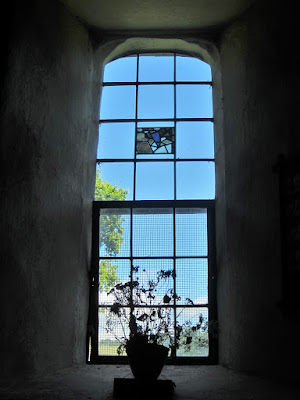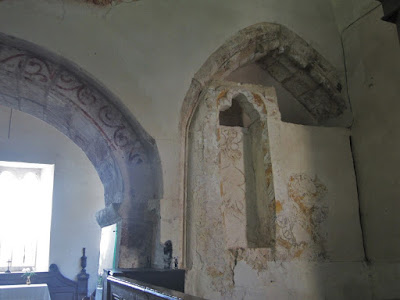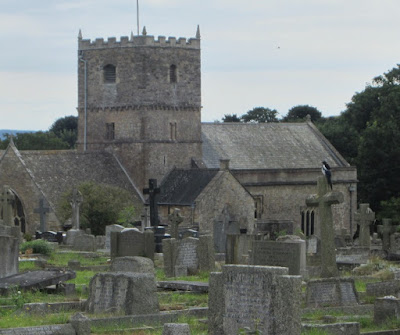 After an enjoyable evening's poetry at Bradford on Avon the night before, courtsy of Dawn Gorman's Words and Ears, Pameli and I were on the road relatively early for a morning jaunt to the Church of St James of Compostela in Cameley, North Somerset.
After an enjoyable evening's poetry at Bradford on Avon the night before, courtsy of Dawn Gorman's Words and Ears, Pameli and I were on the road relatively early for a morning jaunt to the Church of St James of Compostela in Cameley, North Somerset. As soon as we entered the churchyard we were met by its resident robin, who seemed quite unbothered by our presence.
Maybe s/he was trying to draw our attention to various headstones, like this one to Charles Sage, who died in 1808. It has a coal wagon carved on it - a reminder of the North Somerset coalfield.
Or this to a Quarman, who died on November 17th. His age - 67 - was left out and added with an omission mark. Damage to one side means key details are missing, though t'internet names him as James and gives his year of death as 1783.
St James is one of those churches that got left behind when its congregation shifted, in this case to Temple Cloud, which developed in Victorian times around what is now the A37, just under a mile to the east. Its gradual decline meant it escaped the attention of Victorian 'restorers'.
 No worries about getting into it as it is cared for by the Churches Conservation Trust and open daily in the summer. First, though, we admired some remnants of paint on the Norman doorway in the porch.
No worries about getting into it as it is cared for by the Churches Conservation Trust and open daily in the summer. First, though, we admired some remnants of paint on the Norman doorway in the porch. Inside, a hotchpotch of ancient and not-so-ancient fixtures and fittings, murals and carvings
John Betjeman called St James 'Rip Van Winkle's Church', and it's true, a history of the Church can be traced in its fabric and fittings. Pre-Reformation wall paintings, discovered behind layers of whitewash in the 1960s, line up alongside seats of royal arms and the Puritan-approved Ten Commandments; the vestiges of mediaeval side chapels and the mediaeval door to the rood screen partly obscured by 17th and 18th century box pews and the 18th century and 19th century galleries.
18th century hat pegs, far left
The last surviving pieces of the Church's mediaeval glass
The pulpit with its magnificent sounding board is dated 1637. This is where the sermon would have been delivered; the rest of the service being conducted from the reading desk.
The 12th century font with its cover, which was made in 1634 at a cost of £1 12s 4d
An iron peg which could have been designed by C F A Voysey, though I suspect it's a fair bit earlier.
 And then there are the wall paintings: here, all that remains of what would have been a huge early 14th century St Christopher carrying the infant Christ, namely, a foot surrounded by little fishes and a fearsome crab.
And then there are the wall paintings: here, all that remains of what would have been a huge early 14th century St Christopher carrying the infant Christ, namely, a foot surrounded by little fishes and a fearsome crab.The lower part of the royal arms of King James I (1603-25), most of which has been obscured by the gallery above.
A contemporaneous set of the Ten Commandments; above, the traces of a yellow sun or 'Glory'.
A damask pattern of what Pameli and I mistook for candles at first, but are 15th century acorns and oak leaves.
Red dash and scroll patterns from the 1200s on the chancel arch, and early 15th century black and yellow damask patterns in the former side chapel.
At the back of the church, carved into the seat of one of the narrow mediaeval pews, there's a design that looks very like the daisy wheels or hexafoils that protect the tithe barn at Bradford on Avon from the evil eye. While I snapped things in dim corners, Pameli and I swapped hex stories, mine being about the outlines of shoes I've come across in various churches and churchyards.
 It was only when I uploaded my photos to my laptop that I realised St James has its own sole outlines.
It was only when I uploaded my photos to my laptop that I realised St James has its own sole outlines. The guide to the Church describes these as 'three pieces of lead from the roof, where presumably those who laid or repaired it autographed it with their footprints and the dates 1733, 1757 and 1795.' But like the lead outlines on the roof at Muchelney, and the other examples I've come across, I think they might well be examples of apotropaios.
 The robin was still knocking about too, and gave me quite a shock when I went to sit on the bench for a moment.
The robin was still knocking about too, and gave me quite a shock when I went to sit on the bench for a moment.  There was just time to admire the poultry belonging to nearby Cameley Lodge (is that cockerel a Buff Orpington?) ...
There was just time to admire the poultry belonging to nearby Cameley Lodge (is that cockerel a Buff Orpington?) ...  ... and views so bucolic we seemed to have stumbled into an Eclogue. All this a bare 11 miles from the centre of Bristol, our final destination.
... and views so bucolic we seemed to have stumbled into an Eclogue. All this a bare 11 miles from the centre of Bristol, our final destination. 



























































